|
This species has been introduced into California. It is not a native species.
|
Click here for information about how to tell if a snake is a Brahminy Blindsnake or a Western Threadsnake. It's not easy to see the tiny details on these little snakes, especially when they are scared and squirming around, so if you are still in doubt of the species after checking the identification information, please contact Dr. Pauly anyway. You are welcome to contact me at this web site also if you need to.
|
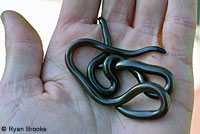 |
 |
 |
Two adults, San Diego County
© Ryan Brooks |
Adult, San Diego County
© Ryan Brooks |
Adult, San Diego County
© Ryan Brooks |
 |
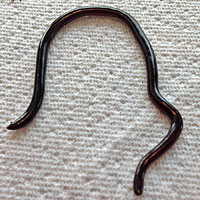 |
|
Adult, San Diego County
© Ryan Brooks |
Specimen found in a home in
Chula Vista, San Diego County 2015 |
|
| |
| Brahminy Blindsnakes From Outside California |
 |
| Adult, Kauai, Hawaii |
 |
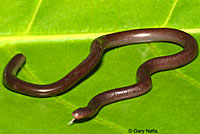 |
 |
| Adult female (all snakes of this species are female), Kauai, Hawaii |
Adult, showing tongue, Kauai, Hawaii |
Adult, Kauai, Hawaii |
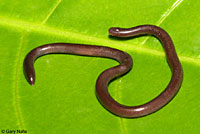 |
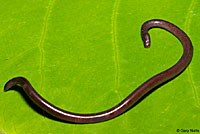 |
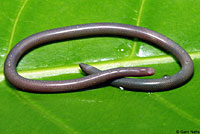 |
| Adult, Kauai, Hawaii |
Adult, Kauai, Hawaii |
Underside of adult, Kauai, Hawaii |
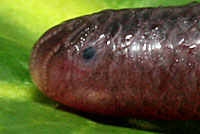 |
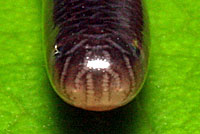 |
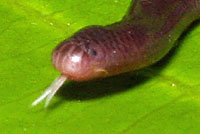 |
| Eye |
Nose |
Tongue |
 |
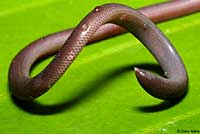 |
 |
| Spine on end of tail |
Adult, Monroe County, Florida |
| |
|
|
| Habitat |
 |
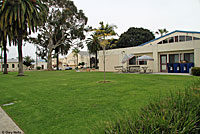 |
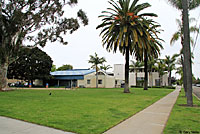 |
Three views of the area where the snakes were first documented in Chula Vista, San Diego County, in 2011.
They have subsequently been observed in many other places in the state, mostly urban and suburban areas in coastal Southern California.
|
| |
| Short Video |
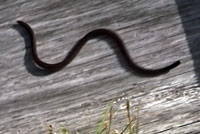 |
YOUTUBE |
|
| A Brahminy Blind Snake found in Florida is released, and crawls away rapidly with serpentine motion. |
This YouTube video from the Natural History Museum of Los Angeles gives information and a good look at a Brahminy Blindsnake. |
|
|
|
|
| Description |
Not Dangerous - This snake does not have venom that can cause death or serious illness or injury in most humans.
Commonly described as "harmless" or "not poisonous" to indicate that its bite is not dangerous, but "not venomous" is more accurate. (A poisonous snake can hurt you if you eat it. A venomous snake can hurt you if it bites you.)
|
| Size |
2.5 - 7 inches in length (14 - 18 cm.) This is one of the smallest snakes in the world.
|
| Appearance |
A small, dark, worm-like snake with smooth, shiny scales, a short head with no neck, a short tail which ends in a small spine, and light spots where the eyes should be.
18 - 20 midbody scale rows.
20 uniform rows of costal scales.
The nasal shields are divided and the eye is not entirely in the Ocular shield. |
| Color and Pattern |
Color is typically dark brown, but can be pale or yellowish brown, or grey.
The underside is lighter than the rest of the body.
|
| Similar Snakes in California |
Brahminy Blindsnakes look very much like California native Western Threadsnakes. You can't tell the difference between the two species without looking closely at one or more tiny details - the rostral scale, the dark eye spot, or the length of the tail.
Go to this page for a more detailed explanation on comparing the Western Threadsnake with the Braminy Blindsnake.
|
| Life History and Behavior |
This species has colonized much of the world by stowing away in the soil of nursery plants, due to its small size and ability to reproduce on its own without having to find a mate of the same species.
Spends much time underground, but also found underneath surface objects and on the surface, especially after saturating rains.
In California they show a lot of surface activity from the end of August to mid October. (GP)
The eyes are not capable of seeing, but they can detect the presence of light. |
| Diet and Feeding |
| Eats ants, insect larvae, and other small invertebrates. |
| Reproduction |
This snake is parthenogenetic - reproduction is asexual. Growth and development of embryos takes place without fertilization from a male snake. All species collected have been females.
Females are oviparous - they lay 2 to 7 tiny eggs.
Up to eight offspring are produced at a time.
The ability of a single female snake to reproduce has helped this species to spread around the world more easily than species which require sexual reproduction between a male and a female.
This is the only parthenogenetic snake species known so far, (although Acrochordus arafurae might also be parthenogenetic and some gartersnake species have reproduced without males in captivity.)
|
| Habitat |
Prefers warm areas with high soil humidity. Typically found in urban and agricultural areas near ant and termite nests, but also found in gardens, jungles, forests, and other habitats. Usually found under logs, rocks, rotting wood, moist leaves and humus.
|
| Geographical Range |
This is the most wide-ranging terrestrial snake in the world. It is most likely native to South Asia, but has been reported worldwide in the warmer areas of every continent except Antarctica, though it is still absent from most of Europe.
In the United States the Brahminy Blindsnake has been established in California, Arizona, Georgia, Florida, Hawaii, Louisiana, Massachusetts, South Carolina, Texas, and Virginia, and will probably become established elsewhere.
|
| Sightings in California |
The species has been observed in California since about the year 2000 and has spread rapidly.
As of 2025 Brahminy Blindsnakes have become widespread in coastal San Diego, Orange, and Los Angeles counties and parts of western Riverside County. They have also been found in western San Bernardino County and southern Ventura County, at a few locations in the Coachella Valley, in Bakersfield and Kern County, and are most likely found in other locations in the southern San Joaquin Valley. They are to be expected now just about anywhere in coastal Southern California and the Inland Empire.
You can try to keep up with the spread by checking the observations and map on iNaturalist.
------------------------------------------------------------------------------------------------------------------------------------------------------------------
The first record
from California was published in 2010:
Palmer, Daniel D., and Robert N. Fisher. Herpetological Review Volume 41, Number 4 - December 2010 P. 518.
"RAMPHOTYPHLOPS BRAMINUS (Brahminy Blind Snake). USA: CALIFORNIA: San diego co.: City of Chula Vista ....
07 November 2006. Marcos Dominguez, Sarmed D. Alzubaidi, and Stanley O’Gara.
A second specimen was collected on 28 September 2009 by Daniel D. Palmer, Tony E. Garcia, Trevor H. Jordan. Verified by Jens Vindum. California Academy of Sciences (CAS 244221–244222).
This is the first record for California and the west coast of the USA (Kraus 2009. Alien Reptiles and Amphibians: A Scientific Compendium and Analysis. Invading Nature: Springer Series in Invasion Ecology 4. Springer-Verlag. 563 pp.). Apparently reproducing and established given that the first specimen was an adult collected in 2006 and the second specimen collected in 2009 was a small juvenile. Both were found in an urban setting. It is not known if this species will invade native habitats in southern California or presents a risk to native species. Urban Chula Vista is dominated by invasive Argentine Ants (Linepithema humile) and it is assumed that this invasive will be abundant prey for the snake.
Submitted by DANIEL D. PALMER, Wildlife Research Institute, 18030 Highland Valley Road, Ramona, California 92065, USA; and ROBERT N. FISHER U.S. Geological Survey, San Diego Field Station, 4165 Spruance Road, Suite 200, San Diego, California 92101-0812, USA; e-mail: rfisher@usgs.gov."
|
| Notes on Taxonomy |
Formerly Ramphotyphlops braminus - Brahminy Blindsnake (Daudin, 1803)
|
| Conservation Issues (Conservation Status) |
| None known. |
|
|
Taxonomy |
| Family |
Typhlopidae |
Blindsnakes |
Merrem, 1820 |
| Genus |
Indotyphlops |
South Asian Blindsnakes |
Hedges, Marion, Lipp, Marin, and Vidal, 2014 |
Species
|
braminus |
Brahminy Blindsnake |
(Daudin, 1803) |
|
Original Description |
Ramphotyphlops: Fitzinger, 1843
R. braminus: (Daudin, 1803)
|
|
Meaning of the Scientific Name |
Indotyphlops - Indo- refers to the Indian subcontinent, referring to the snake's geographic origin
typhlops = blind, referring to the snake's lack of eyes.
braminus = Latinized form of "Brahmin" a Hindu caste.
(formerly Ramphotyphlops = Greek "rhamphos" = a curving beak or bill, "typhlops" = blind.)
|
|
Alternate Names |
Common Blind Snake
Flowerpot Snake
Island Blind Snake
Hawaiian Blind Snake
|
|
Related or Similar California Herps |
Southwestern Threadsnake - Rena humilis humilis
Desert Threadsnake - Rena humilis cahuilae
|
|
More Information and References |
Palmer, Daniel D., and Robert N. Fisher. Herpetological Review Volume 41, Number 4 - December 2010 P. 518.
McKeown, Sean. A Field Guide to Reptiles and Amphibians in the Hawaiian Islands. 1996.
Bartlett, Richard D., and Patricia Bartlett. Guide and Reference to the Snakes of Eastern and Central North America (North of Mexico) 2006).
Tennant, Alan. A Field Guide to Snakes of Florida (The Geological Field Guide Series) 1997.
Conant, R., Collins, J. T. Peterson Field Guide to Reptiles and Amphibians of Eastern and Central North America, Third Edition. 1998.
Wall, Frank. Snakes of Ceylon. 1921.
|
|
|
The following conservation status listings for this animal are taken from the July 2025 State of California Special Animals List and the July 2025 Federally Listed Endangered and Threatened Animals of California list (unless indicated otherwise below.) Both lists are produced by multiple agencies every year, and sometimes more than once per year, so the conservation status listing information found below might not be from the most recent lists, but they don't change a great deal from year to year.. To make sure you are seeing the most recent listings, go to this California Department of Fish and Wildlife web page where you can search for and download both lists:
https://www.wildlife.ca.gov/Data/CNDDB/Plants-and-Animals.
A detailed explanation of the meaning of the status listing symbols can be found at the beginning of the two lists. For quick reference, I have included them on my Special Status Information page.
If no status is listed here, the animal is not included on either list. This most likely indicates that there are no serious conservation concerns for the animal. To find out more about an animal's status you can also go to the NatureServe and IUCN websites to check their rankings.
Check the current California Department of Fish and Wildlife sport fishing regulations to find out if this animal can be legally pursued and handled or collected with possession of a current fishing license. You can also look at the summary of the sport fishing regulations as they apply only to reptiles and amphibians that has been made for this website.
This snake is not included on the Special Animals List, which indicates that there are no significant conservation concerns for it yet in California.
|
| Organization |
Status Listing |
Notes |
| NatureServe Global Ranking |
|
|
| NatureServe State Ranking |
|
|
| U.S. Endangered Species Act (ESA) |
None |
|
| California Endangered Species Act (CESA) |
None |
|
| California Department of Fish and Wildlife |
None |
|
| Bureau of Land Management |
None |
|
| USDA Forest Service |
None |
|
| IUCN |
|
|
|
|
 Red: General likely range of non-native
Red: General likely range of non-native 






















